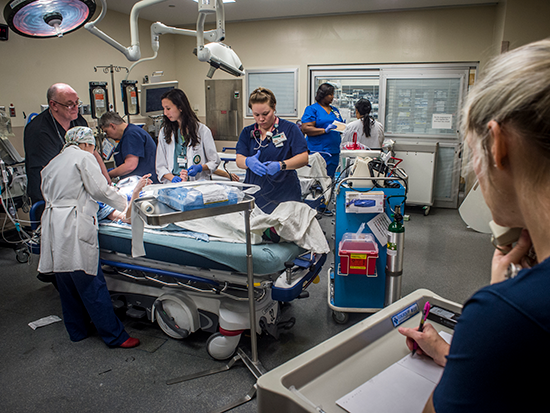Media contact: Bob Shepard
 UAB Hospital re-verified as a Level I Trauma Center, marking 23 years of holding that designation.The University of Alabama at Birmingham Hospital has been re-verified as a Level I Trauma Center by the American College of Surgeons Committee on Trauma. UAB Hospital remains Alabama’s only ACS-verified Level I adult trauma center.
UAB Hospital re-verified as a Level I Trauma Center, marking 23 years of holding that designation.The University of Alabama at Birmingham Hospital has been re-verified as a Level I Trauma Center by the American College of Surgeons Committee on Trauma. UAB Hospital remains Alabama’s only ACS-verified Level I adult trauma center.
The COT’s Consultation/Verification Program for Hospitals, established by the ACS in 1987, promotes the development of trauma centers. Verified trauma centers must meet the essential criteria that ensure trauma care capability and institutional performance.
UAB Hospital was first verified in 1999 and has been re-verified every three years since. Verification represents that UAB provides not only the hospital resources necessary for trauma care, but also the entire spectrum of care to address the needs of all injured patients, from the pre-hospital phase through the rehabilitation process.
“We’re proud to have met the rigorous standards for Level I Trauma verification by the American College of Surgeons for the past 23 years,” said Jeffrey Kerby, M.D., Ph.D., director of the Division of Trauma and Acute Care Surgery within the UAB Department of Surgery. “This designation represents our ability and commitment to providing the highest level of trauma care to patients throughout Alabama and surrounding regions.”
There are three levels of verification for adult hospitals and two for pediatric hospitals. Level I is the most comprehensive and is reserved for trauma centers with the most advanced capabilities for the management of traumatic injuries. A review of the hospital was conducted by an external team experienced in the field of trauma, utilizing a standard set of criteria.
UAB manages 35 percent of all trauma patients in the state of Alabama. In 2021, UAB saw a historic increase in volume, handling 6,466 trauma evaluations — a 34 percent increase over the past two years. Despite the increase in volume, UAB continues to improve its quality of care. 2021 saw UAB’s highest survival rate ever, at 96 percent.
“Obtaining ACS reverification as a Level I Trauma Center recognizes the institutional commitment UAB continues to make to ensure the residents of Alabama have access to the highest quality of trauma care,” said Daniel Cox, M.D., chief of the UAB Trauma Service. “In order to provide the highest standards of trauma care, a large amount of resources are required to be ready 24 hours a day, seven days a week. I’m proud to be a part of an institution that is willing to make that commitment to the injured patients of our state.”
The Division of Trauma and Acute Care Surgery has a core group of 17 dedicated trauma surgeons in addition to the support of active-duty Air Force surgeons as part of a longstanding military-civilian partnership. The trauma service also relies on several subspecialty services, including orthopaedic trauma, neurosurgery, vascular surgery, radiology, emergency medicine and other specialists as needed.
 Jeffrey Kerby, M.D, Ph.D., director of the Division of Trauma and Acute Care SurgeryThe division trains multiple surgery and emergency medicine residents and four trauma and surgical critical care fellows each year. The trauma care team includes nurse practitioners, physician assistants, a physiatrist, clinical coordinators, epidemiologists, and case managers/social workers. Nurses trained specifically in trauma care work in multiple areas throughout the hospital, including the emergency department, trauma/burn intensive care unit, the neurosurgical intensive care unit, trauma/burn nursing unit, and acute trauma care unit, managing an average daily census of 85 trauma patients.
Jeffrey Kerby, M.D, Ph.D., director of the Division of Trauma and Acute Care SurgeryThe division trains multiple surgery and emergency medicine residents and four trauma and surgical critical care fellows each year. The trauma care team includes nurse practitioners, physician assistants, a physiatrist, clinical coordinators, epidemiologists, and case managers/social workers. Nurses trained specifically in trauma care work in multiple areas throughout the hospital, including the emergency department, trauma/burn intensive care unit, the neurosurgical intensive care unit, trauma/burn nursing unit, and acute trauma care unit, managing an average daily census of 85 trauma patients.
“The unwavering dedication and passion for trauma care that is exhibited by the multiple disciplines that make up the extended trauma care team allow us to be ready and able to provide the highest level of care to patients in their moment of need,” Kerby said.
The program maintains a trauma registry along with a quality improvement and patient safety program that monitors all aspects of UAB trauma care. The division also participates in community outreach and injury prevention, like working with local and state legislators to raise awareness; providing distracted driving courses to teens; bringing Stop the Bleed courses to schools, churches and other groups throughout the state; and teaching fall prevention at senior centers. The division is in the early stages of implementing a Trauma Survivors Network and Hospital-linked Violence Intervention Program, which will provide resources and peer support to trauma patients.
“At UAB, we are passionate about bringing knowledge to the community with the goal of reducing preventable injuries and death,” said Holly Waller, senior director of Trauma, Burn and Inpatient Wound Services. “We meet people where they are with evidence-based programs to address major causes of injury across Alabama.”
The division maintains a robust and active multidisciplinary research program through its Center for Injury Science. Under the direction of Jan Jansen, MBBS, Ph.D., the CIS directs large-scale multicenter clinical trials in trauma care and includes a basic science component led by Jillian Richter, Ph.D. The division is also a participant in the multicenter Crash Injury Research Engineering Network under the direction of Shannon Carroll, M.D.
The American College of Surgeons is a scientific and educational association of surgeons that was founded in 1913 to raise the standards of surgical education and practice and to improve the care of the surgical patient. The College has more than 84,000 members and is the largest association of surgeons in the world. Longstanding achievements have placed the ACS in the forefront of American surgery and have made it an important advocate for all surgical patients.